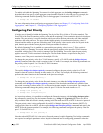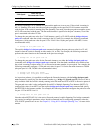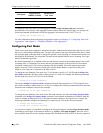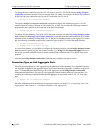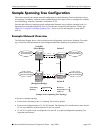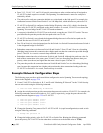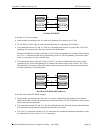
Sample Spanning Tree Configuration Configuring Spanning Tree Parameters
page 5-30 OmniSwitch 6600 Family Network Configuration Guide April 2006
• Ports 2/1-3, 2/8-10, 3/1-3, and 3/8-10 provide connections to other switches and are all assigned to
VLAN 255 on their respective switches. The Spanning Tree administrative status for each port is
enabled by default.
• The path cost for each port connection defaults to a value based on the link speed. For example, the
connection between Switch B and Switch C is a 100 Mbps link, which defaults to a path cost of 19.
• VLAN 255 on Switch D is configured with a Bridge ID priority value of 10, which is less than the
same value for VLAN 255 configured on the other switches. As a result, VLAN 255 was elected the
Spanning Tree root bridge for the VLAN 255 broadcast domain.
• A root port is identified for VLAN 255 on each switch, except the root VLAN 255 switch. The root
port identifies the port that provides the best path to the root VLAN.
• VLAN 255 on Switch A was elected the designated bridge because it offers the best path cost for
Switch B to the root VLAN 255 on Switch D.
• Port 2/9 on Switch A is the designated port for the Switch A to Switch B connection because Switch A
is the designated bridge for Switch B.
• Redundant connections exist between Switch D and Switch C. Ports 2/2 and 3/9 are in a discarding
(blocking) state because this connection has a higher path cost than the connection provided through
ports 2/3 and 3/8. As a result, a network loop condition is avoided.
• Redundant connections also exist between Switch A and Switch B. Although the path cost value for
both of these connections is the same, ports 2/8 and 3/3 are in a discarding state because their port
priority values (not shown) are higher than the same values for ports 2/10 and 3/1.
• The ports that provide the connection between Switch B and Switch C are in a discarding (blocking)
state, because this connection has a higher path cost than the other connections leading to the root
VLAN 255 on Switch D. As a result, a network loop is avoided.
Example Network Configuration Steps
The following steps provide a quick tutorial that configures the active Spanning Tree network topology
shown in the diagram on page 5-29.
1 Create VLAN 255 on Switches A, B, C, and D with “Marketing IP Network” for the VLAN descrip-
tion on each switch using the following command:
-> vlan 255 name "Marketing IP Network"
2 Assign the switch ports that provide connections between each switch to VLAN 255. For example, the
following commands entered on Switches A, B, C, and D, respectively, assign the ports shown in the
example network diagram on page 5-29 to VLAN 255:
-> vlan 255 port default 2/8-10
-> vlan 255 port default 3/1-3
-> vlan 255 port default 3/8-10
-> vlan 255 port default 2/1-3
3 Change the Spanning Tree protocol for VLAN 255 to 802.1w (rapid reconfiguration) on each switch
using the following command:
-> bridge 255 protocol 1w
4 Change the bridge priority value for VLAN 255 on Switch D to 10 using the following command
(leave the priority for VLAN 255 on the other three switches set to the default value of 32768):



